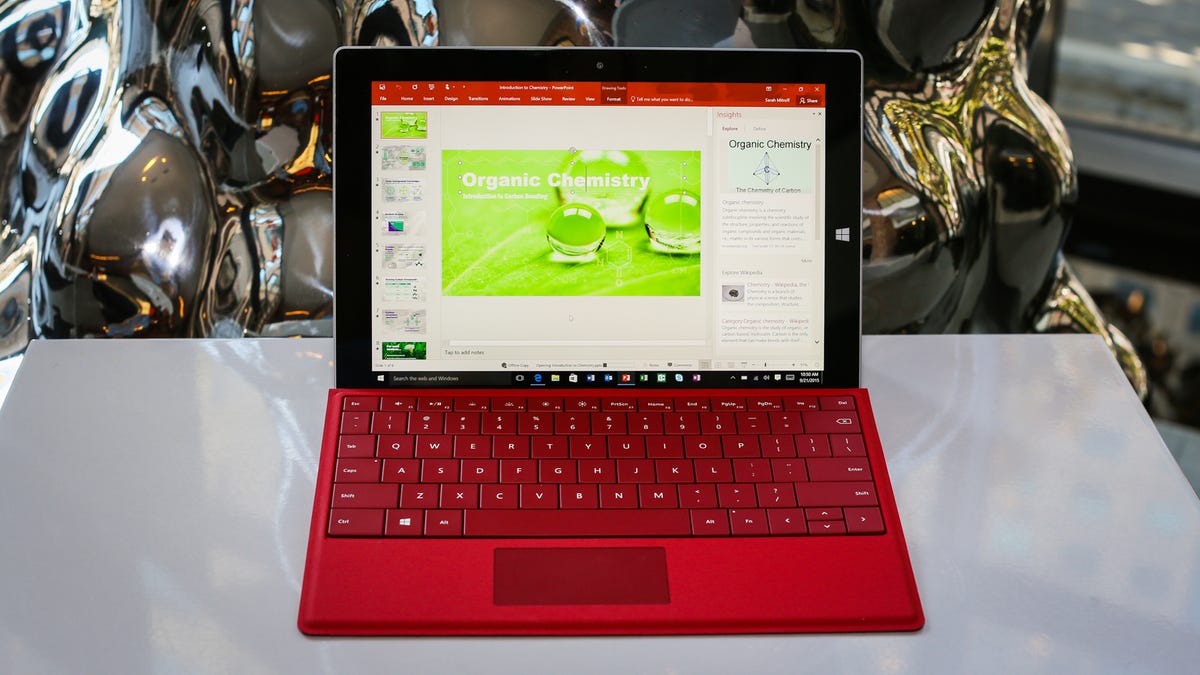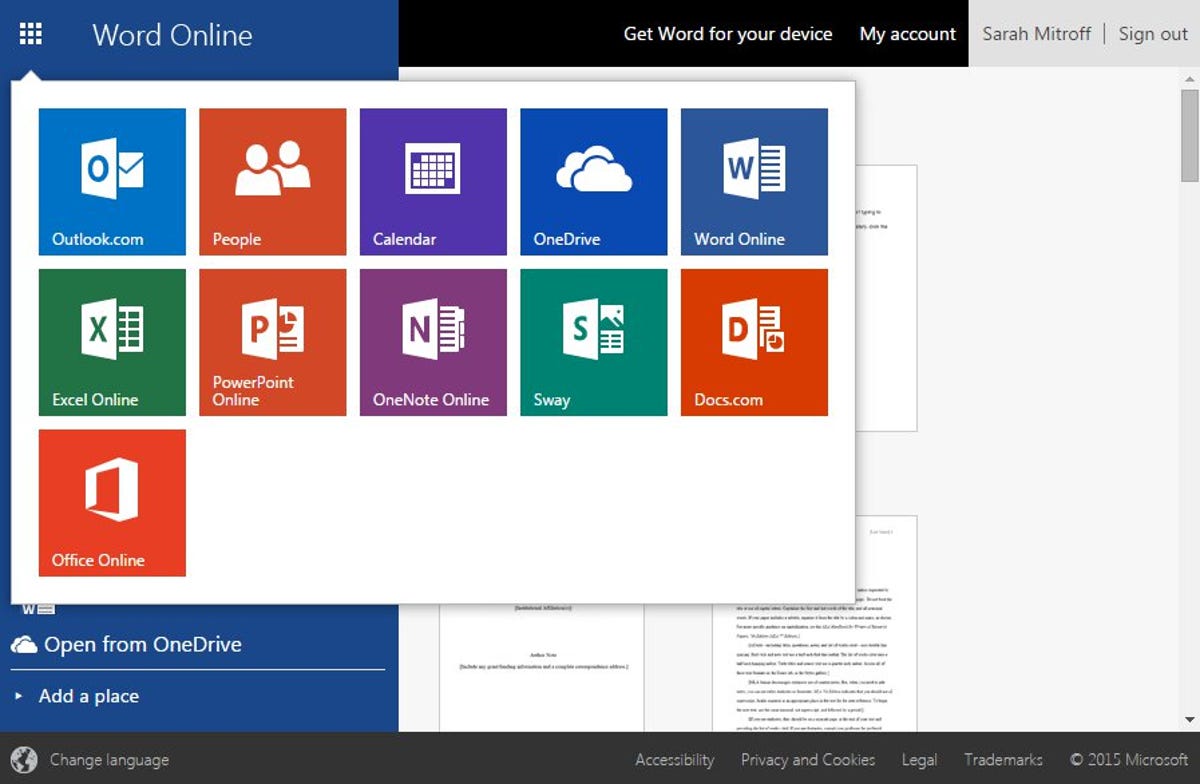This week, Office 2016 arrives for Windows and the software is a major upgrade to the previous versions of Microsoft’s productivity suite. If you’re eager to use the new apps, they are available now, but first, you have to figure out how you’ll purchase them.
Long gone are the days of grabbing a box of CDs at the store — today, subscriptions are the norm, but they’re not the only way to buy. Because of that, you get several different ways to buy Office 2016, and you’ll be forgiven if you don’t know which one to pick. Microsoft doesn’t exactly make it simple to tell the difference between your choices.
To make the decision a bit easier, this guide will go over the three different ways to use Office and what you get with each pick.

Josh Miller/CNET
Option 1: Office.com and Office Mobile apps — Free
Office.com provides completely free, but slightly limited, online-only versions of Word, Excel, PowerPoint, Outlook and other tools. Around since 2010, the website has largely flown under the radar, overshadowed by the desktop versions of Office. All you need to use it is a free Microsoft account, which you get here. (Of course, if you already use nearly any Microsoft product — Skype, OneDrive, Xbox Live — you already have one.)
Using Office.com, you can edit and create new documents, spreadsheets and slideshows, using many of the same features you’d get with Office on the desktop. In many ways, it’s similar to Google Docs, which is also exclusively online and free with a Google account.
With free comes a few limitations. First, the online tools are missing some advanced features you get with the full versions, like tracking changes in Word, advanced chart types in Excel and many slide transitions in PowerPoint.
The other big drawback is that you cannot open and edit files that live on your computer. In order to open a file through Office.com, you’ll need to store it in either OneDrive or Dropbox first. Luckily, you can easily save a copy of a file you create or edit to your computer without any hassle. Any changes you make are also automatically saved in OneDrive.
When you’re away from a computer, you can also use the free Office mobile apps for Android , iPhone and iPad . Like the browser-based version, these apps have all the basic Word, Excel and PowerPoint features, with some limitations. If you have an Office 365 (see below), you’ll unlock all of the apps’ tools.

 Enlarge Image
Enlarge ImageScreenshot by Sarah Mitroff/CNET
Option 2: Office 365 — Subscription
Office 365 is a monthly or yearly memberships that gets you the full desktop versions of Office, plus cloud storage with OneDrive, email with Outlook, and a bunch of extras.
With Office 2016 , the full versions include new sharing features that let you work together with others in real-time, integrations with messaging app Skype, a tool that uses Microsoft’s search engine Bing to help you research while you’re working and more. The most enticing reason to get a subscription is that you’ll always get new versions Office when Microsoft releases them.
There are several different types of Office 365 subscription, each getting you different features. The two most popular subscription tiers are Home and Personal. Office 365 Home is meant for families, since up to five people can be on the same membership and you can install the Office apps on up to five different PCs or Macs, plus use the full versions of the Office apps on Android and iOS phones and tablets. You also get 1TB of storage for each person in OneDrive, plus 60 free minutes per month per user on Skype to make phone calls all around the world.
Office 365 Personal is designed for one person with one computer to install the Office apps. You can also use the full versions of the mobile apps, and the subscription includes 1TB of OneDrive storage. Plus, you get 60 Skype minutes every month.
Here’s a full breakdown of what you get with Office 365 Home and Personal:
| Office 365 Home | Office 365 Personal | |
|---|---|---|
| Price | $9.99 (£7.99, AU$12) per month or $99 (£79, AU$119) per year | $6.99 (£5.99, AU$9) per month or $69 (£59, AU$89) per year |
| Number of devices you can install Office apps | 5 PCs or Macs, plus 5 Android or iOS mobile devices | 1 PC or Mac, plus one mobile device |
| OneDrive | 1TB storage space included | 1TB per person, up to five people, included |
| Word | Yes | Yes |
| Excel | Yes | Yes |
| PowerPoint | Yes | Yes |
| OneNote | Yes | Yes |
| Outlook | Yes | Yes |
| Publisher | Yes | Yes |
| Access | Yes | Yes |
| Skype Minutes | Free 60 minutes per month for one person | Free 60 minutes per month for up to 5 people, each |
For students, Microsoft also offers Office 365 for free if you attend a qualifying school, college or university. If not, you can get a discounted rate with Office 365 University. It costs $79 (£59, AU$99) for a four-year subscription and you can install the Office apps on two different devices, either two computers or on a computer and mobile device, like a tablet or smartphone.
Option 3: Office 2016 — One-time purchase
The last option is to buy a single copy of Office 2016 outright, starting at $149.99 (£119.99, AU$169). For that price, you get just Office 2016 for PC or Mac, with whatever features are available as of September 22, 2015. Microsoft takes a snapshot of the software on that date and makes that version available for purchase.
If Microsoft adds additional features to Office down the road, the version you get with a one-time purchase will not get them. You’ll only get stability and security updates that ensure your software keeps working as it should. When a new version of Office arrives, you’ll need to pay to upgrade.
Additionally, once you pay for the software, it’s yours to use for as long as you want. This is different from Office 365, where if you cancel your subscription, the Office apps you downloaded with your membership will only run in a reduced functionality mode, which only lets you open and print files, not edit them or create new ones.
Here’s the pricing breakdown and what you get with a one-time purchase:
| Office Home & Student 2016 | Office Home & Business 2016 | Office for Mac Home & Student 2016 | Office for Mac Home & Business 2016 | |
|---|---|---|---|---|
| Price | $149 (£119.99, AU$179) one-time fee | $229 (£229.99, AU$299) one-time fee | $149 (£119.99, AU$169) one-time fee | $229 (£229.99, AU$299) one-time fee |
| Number of devices you can install Office apps | 1 PC | 1 PC | 1 Mac computer | 1 Mac computer |
| Word | Yes | Yes | Yes | Yes |
| Excel | Yes | Yes | Yes | Yes |
| PowerPoint | Yes | Yes | Yes | Yes |
| OneNote | Yes | Yes | Yes | Yes |
| Outlook | No | Yes | No | Yes |
| Publisher | No | No | No | No |
| Access | No | No | No | No |
| Skype Minutes | None | None | None | None |
I didn’t include OneDrive in the chart above, but with a free Microsoft account, you automatically get 15GB of storage space. A one-time purchase of Office 2016 doesn’t get you any additional space.
Which to get?
Ready to make a choice but still aren’t sure? Here are our guidelines to help.
If you haven’t used Office in a while and are reluctant to spend any money, start with Office.com first. Get a feel for the tools offered there and see if they do enough for what you need.
Then, if you need extra features consider purchasing Office 2016 as a one-time purchase. Though it has a bigger up-front cost, it can be cheaper in the long run. If you plan to use Office for more than two years and do not want extra storage space in OneDrive, a one-time purchase will ultimately be cheaper than a subscription. Once you pass the two-year mark, you’ll pay more money per year to keep using Office 365 than the cost of the one-time purchase for Office 2016 Home & Student.
If, however, you want or need the extra features that Office 365 offers, such as extra online storage, always-updated Office applications, and apps for every device, then the subscription is the only way to go. It has the most comprehensive features and it’s well worth paying for, if you’re willing to spend a little extra overall.




